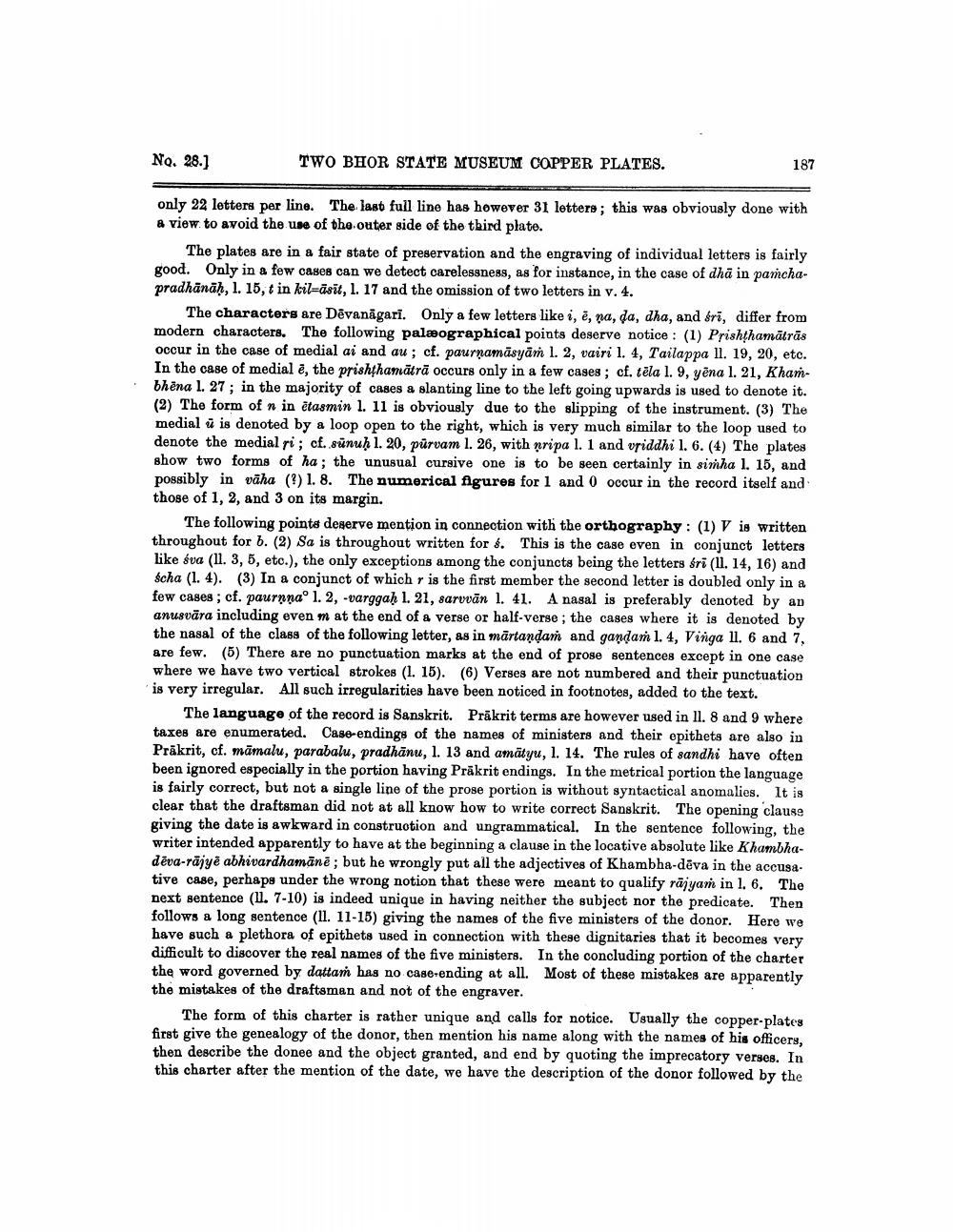________________
No. 28.)
TWO BHOR STATE MUSEUM COPPER PLATES.
187
only 22 letters per line. The last full line has however 31 letters; this was obviously done with & view to avoid the use of the outer side of the third plate.
The plates are in a fair state of preservation and the engraving of individual letters is fairly good. Only in a few cases can we detect carelessness, as for instance, in the case of dha in panchapradhānāḥ, 1. 15, tin kil-asit, l. 17 and the omission of two letters in v. 4.
The characters are Dēvanagari. Only a few letters like i, e, na, da, dha, and tri, differ from modern characters. The following palæographical points deserve notice: (1) Prishthamātrās occur in the case of medial ai and au; cf. paurnamāsyāṁ 1. 2, vairi l. 4, Tailappa 11. 19, 20, etc. In the case of medial e, the prishthamātrā occurs only in a few cases; cf. tēla 1. 9, yēna l. 21, Khambhëna l. 27; in the majority of cases a slanting line to the left going upwards is used to denote it. (2) The form of n in étasmin l. 11 is obviously due to the slipping of the instrument. (3) The medial ù is denoted by a loop open to the right, which is very much similar to the loop used to denote the medial ri; cf. sunuh 1. 20, pūrvam l. 26, with nripa l. 1 and vriddhi 1. 6. (4) The plates show two forms of ha; the unusual cursive one is to be seen certainly in simha l. 15, and possibly in väha () 1. 8. The numerical figures for 1 and 0 occur in the record itself and those of 1, 2, and 3 on its margin.
The following points deserve mention in connection with the orthography: (1) V is written throughout for 6. (2) Sa is throughout written for &. This is the case even in conjunct letters like sva (11. 3, 5, etc.), the only exceptions among the conjuncts being the letters sri (11. 14, 16) and scha (1. 4). (3) In a conjunct of which r is the first member the second letter is doubled only in a few cases; cf. paurnna° 1.2, -varggah 1. 21, sarvvān 1. 41. A nasal is preferably denoted by an anusvāra including even m at the end of a verse or half-verse; the cases where it is denoted by the nasal of the class of the following letter, as in mārtandar and gandan 1.4, Virga 11. 6 and 7, are few. (5) There are no punctuation marks at the end of prose sentences except in one case where we have two vertical strokes (1. 15). (6) Verses are not numbered and their punctuation is very irregular. All such irregularities have been noticed in footnotes, added to the text.
The language of the record is Sanskrit. Prākrit terms are however used in ll. 8 and 9 where taxes are enumerated. Case-endings of the names of ministers and their epithets are also in Prākrit, cf. māmalu, parabalu, pradhānu, 1. 13 and amätyu, 1. 14. The rules of sandhi have often been ignored especially in the portion having Prākrit endings. In the metrical portion the language is fairly correct, but not a single line of the prose portion is without syntactical anomalies. It is clear that the draftsman did not at all know how to write correct Sanskrit. The opening clause giving the date is awkward in construction and ungrammatical. In the sentence following, the writer intended apparently to have at the beginning a clause in the locative absolute like Khambhadēva-rājyē abhivardhamānē; but he wrongly put all the adjectives of Khambha-dēva in the accusa. tive case, perhaps under the wrong notion that these were meant to qualify rājyam in l. 6. The next sentence (ul. 7-10) is indeed unique in having neither the subject nor the predicate. Then follows a long sentence (11. 11-15) giving the names of the five ministers of the donor. Here we have such a plethora of epithets used in connection with these dignitaries that it becomes very difficult to discover the real names of the five ministers. In the concluding portion of the charter the word governed by dattam has no case-ending at all. Most of these mistakes are apparently the mistakes of the draftsman and not of the engraver.
The form of this charter is rather unique and calls for notice. Usually the copper-plates first give the genealogy of the donor, then mention his name along with the names of his officers, then describe the doneo and the object granted, and end by quoting the imprecatory verses. In this charter after the mention of the date, we have the description of the donor followed by the




